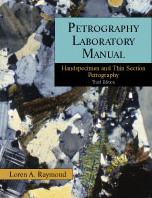Introduction
1. Mineralogy
Rock-Forming Minerals / Handspecimen Descriptions of Minerals / Exercise 1: Mineral Identification in Handspecimen
2. Igneous Rocks
Distinguishing and Describing the Three Classes of Rock / Exercise 2: Distinguishing Igneous, Sedimentary, and Metamorphic Rocks / Description and Classification of Igneous Rocks / Igneous Structures / Igneous Textures / Color and Color Index / Mineral Content and Percentages in Rocks / Alteration and Weathering / Igneous Rock Names and Classifications / Classifications of Phaneritic Feldspathic Rocks / Classifications of Phaneritic Ferromagnesian Rocks / Classifications of Aphanitic Feldspathic Rocks / Classification of Other Aphanitic Rocks / Exercises 3–7: Description and Classification of Igneous Rocks / Exercise 8: Pyroclastic Rocks / Exercise 9: Uncommon Igneous Rocks
3. Sedimentary Rocks
Introduction / Sedimentary Textures / Sedimentary Structures and Other Features / Mineral Composition of Sedimentary Rocks / Matrix and Cement / Color, Percentages, and Alteration and Weathering / Classification and Naming of Sedimentary Rocks / Exercise 10: Description and Classification of Group S, Clastic Sedimentary Rocks / Exercise 11: Description and Classification of Carbonate Sedimentary Rocks / Exercise 12: Description and Classification of Evaporites and Other Group A and P Rocks
4. Metamorphic Rocks
Introduction / Metamorphic Structures / Metamorphic Textures / Mineral Composition of Metamorphic Rocks / Color and Other Features / Naming and Classification of Metamorphic Rocks / Metamorphic Facies / Exercise 13: Mafic and Ultramafic Metamorphic Rocks / Exercise 14: Pelitic Metamorphic Rocks / Exercise 15: Quartz-Feldspar Rocks / Exercise 16: Carbonate Rocks / Exercise 17: Granoblastic, Diablastic, and Cataclastic Rocks / Exercise 18: Contact/Buchan Facies Series Rocks / Exercise 19: Barrovian Facies Series Rocks / Exercise 20: High Pressure Facies Series Rocks
5. Thin Section Study
Introduction / The Petrographic Microscope / Observing and Categorizing Minerals Using the Petrographic Microscope / Exercise 21: Igneous Rocks in Thin Section / Exercise 22: Metamorphic Rocks in Thin Section / Exercise 23: Sedimentary Rocks in Thin Section
Appendix A1: Mineral Occurences in Selected Rock Groups and Rock Types
Appendix A2: Examples of Mineral Associations in Selected Rocks
Appendix B: Tables for the Identification of Minerals in Thin Section
Appendix C: Staining Rocks (Exercise 24: Staining Rocks for Quartz and Feldspar)
Appendix D: Supplementary Questions for Exercises

170 pages, $42.95 list
1-57766-665-8
978-1-57766-665-3
© 2010
spiral
Similar Titles
Petrography Laboratory Manual
Handspecimen and Thin Section Petrography
Third Edition
Petrography is an important skill for many geologists. It is used as an aid in making geologic maps, in sample collection for detailed studies in disciplines like theoretical petrology and mineralogy, and in a variety of applied fields such as geological engineering, mineral exploration, and fuels exploration. As in previous editions of this outstanding lab manual, Raymond has carefully crafted descriptions, explanations, definitions, diagrams, and tables to prevent confusion, facilitate learning how to distinguish classes and characteristics of rock, and demonstrate the aspects and applications involved in the study of rocks.
Each of the five sections contains multiple exercises to develop and hone observational skills and reinforce understanding—including exercises covering optical petrography, new to this edition. The latest version of the text can be used for handspecimen work only or for both handspecimen and thin section study. An appendix with a mineral identification key of use in optical petrography has been added. Instructors who teach using a general collection of petrology specimens will appreciate that no specific rock samples are required to complete the exercises in this text.
Each of the five sections contains multiple exercises to develop and hone observational skills and reinforce understanding—including exercises covering optical petrography, new to this edition. The latest version of the text can be used for handspecimen work only or for both handspecimen and thin section study. An appendix with a mineral identification key of use in optical petrography has been added. Instructors who teach using a general collection of petrology specimens will appreciate that no specific rock samples are required to complete the exercises in this text.